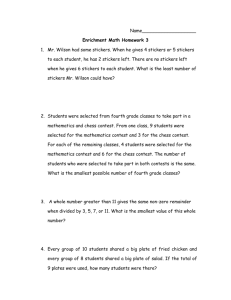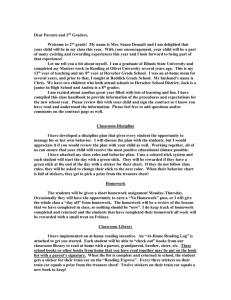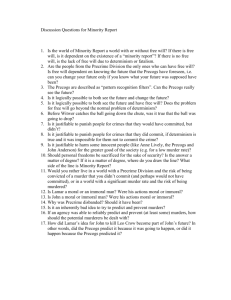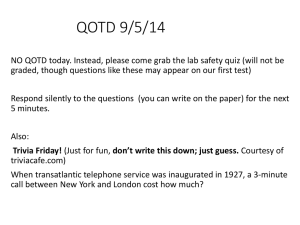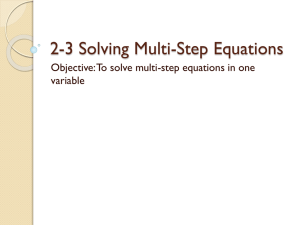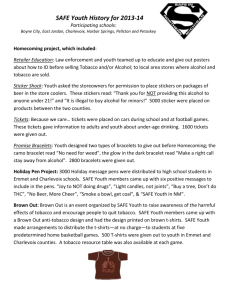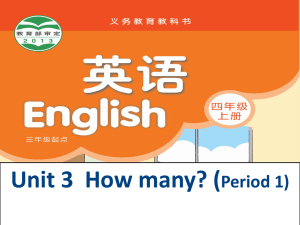Moral objections to quota trade are common in public discussion
advertisement
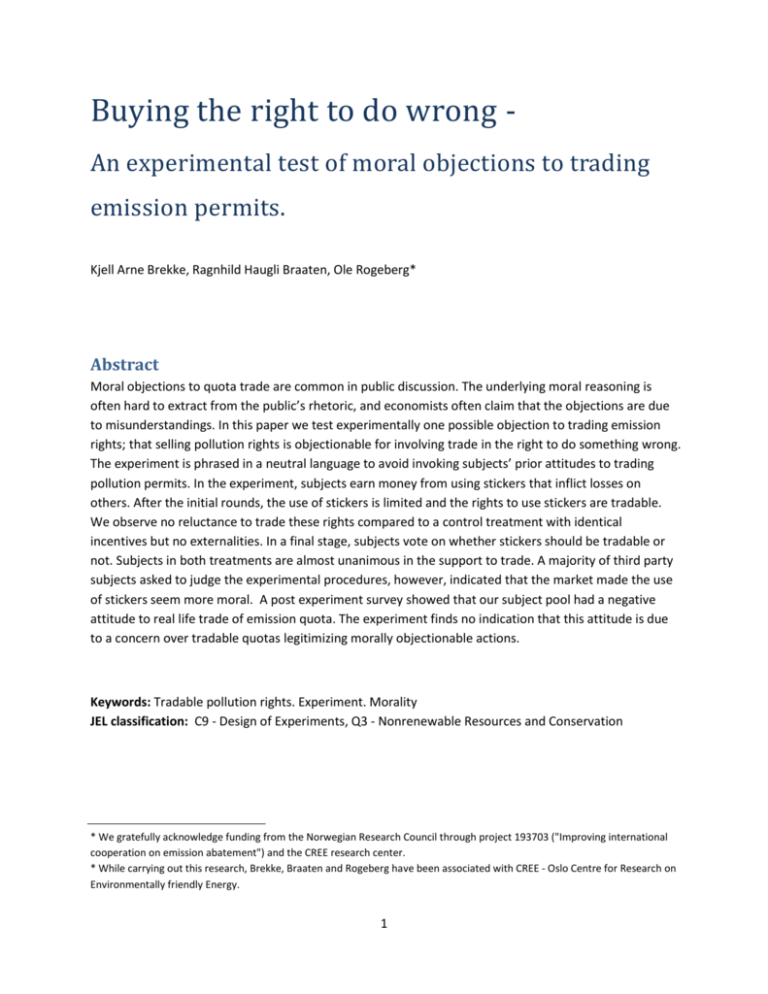
Buying the right to do wrong An experimental test of moral objections to trading emission permits. Kjell Arne Brekke, Ragnhild Haugli Braaten, Ole Rogeberg* Abstract Moral objections to quota trade are common in public discussion. The underlying moral reasoning is often hard to extract from the public’s rhetoric, and economists often claim that the objections are due to misunderstandings. In this paper we test experimentally one possible objection to trading emission rights; that selling pollution rights is objectionable for involving trade in the right to do something wrong. The experiment is phrased in a neutral language to avoid invoking subjects’ prior attitudes to trading pollution permits. In the experiment, subjects earn money from using stickers that inflict losses on others. After the initial rounds, the use of stickers is limited and the rights to use stickers are tradable. We observe no reluctance to trade these rights compared to a control treatment with identical incentives but no externalities. In a final stage, subjects vote on whether stickers should be tradable or not. Subjects in both treatments are almost unanimous in the support to trade. A majority of third party subjects asked to judge the experimental procedures, however, indicated that the market made the use of stickers seem more moral. A post experiment survey showed that our subject pool had a negative attitude to real life trade of emission quota. The experiment finds no indication that this attitude is due to a concern over tradable quotas legitimizing morally objectionable actions. Keywords: Tradable pollution rights. Experiment. Morality JEL classification: C9 - Design of Experiments, Q3 - Nonrenewable Resources and Conservation * We gratefully acknowledge funding from the Norwegian Research Council through project 193703 ("Improving international cooperation on emission abatement") and the CREE research center. * While carrying out this research, Brekke, Braaten and Rogeberg have been associated with CREE ‐ Oslo Centre for Research on Environmentally friendly Energy. 1 1. Introduction When the “environmental revolution” arrived in the 1960s, economists were ready and waiting. - Opening statement of “The theory of environmental policy” (Baumol and Oates 1988) The Times was flooded with scathing letters—mostly from economists, some of them my Harvard colleagues. I failed to understand the virtue of markets, they suggested, or the efficiencies of trade, or the elementary principles of economic rationality. -Philosopher Michael Sandel on reactions to his moral arguments against tradable emission quotas (Sandel 2012) Economists were quick to suggest environmental taxes and tradable emission quotas when the modern environmental movement arrived, but, as Baumol and Oates (1988) pointed out, these solutions were not well received1. Command and control were preferred to economic instruments like quotas and taxes, and while there has been a few application of tradable emission quotas recently, legal instruments still dominate. There was, and still is, a considerable resistance towards both policy instruments, often laced with moral indignation. This is especially so for tradable emission quotas. Why do many non-economist object so strongly to an idea that economists typically support? Do noneconomists fail to understand the basic idea behind quota trade, or has economic training somehow made economists blind to moral issues that others find obvious? To examine this, we designed an experiment where participants could trade the right to do wrong. The wrong involved using ‘stickers’ that gained the user and harmed the other group members, with net harm overall. We examined whether participants found trade in the right to use stickers objectionable both before and after participating in a double-auction trading market. The design did not invoke a climate/environmental context, and the use of terms such as “quotas” or “emissions” was avoided so as not to trigger already held convictions on the morality of emission trading schemes. Skepticism towards tradable emission quotas seem to be widespread. Asked in 2010 whether “Norway ought to take its share of responsibility for greenhouse gas emissions by buying emission quotas from other countries,” a nationally representative survey of the Norwegian population found 46% disagreeing 1 This is not the only issue where economist and non –economist tend to disagree, see Sapienza and Zingales (2013). 2 with the statement2. This negative attitude to tradable emissions quotas is also apparent in official Norwegian policy, which emphasizes targets for domestic abatements at the expense of cost efficiency, and was the result of an intense political debate on the morality of buying quotas abroad (Eyckmans and Kverndokk 2010). One explanation for this skepticism towards tradable emission quotas may be that the public (and politicians) fail to understand how such a system would work and what it would achieve. An alternative explanation may be that economists are unable to see the moral argument that non-economists emphasize. Past experimental results have shown that economics students tend to act more selfishly than other students. While this may be due to selection (Frey and Meyer, 2005), it may also partly be an effect of training. An important feature of the economist training is the strong focus on outcomes, in our context the emphasis on total costs and emissions: If policy A yields better consequences for everyone than policy B, economists will tend to see A as the best option, even if this policy “legitimizes” something others feel should be stigmatized. The view that markets legitimize objectionable actions appears in many contexts. We have observed it in talk shows, cartoons, and discussions with non-economist. A typical argument is to state or suggest that the logic of quota trading would extend to quotas for any number of bad or illegal activities. The satirical website cheatneutral.com claims to “highlight some of the issues surrounding carbon offsetting” by providing people who cheat on their spouses the opportunity to pay others to refrain from doing so – thus offsetting the sin. By “funding someone else to be faithful and NOT cheat [t]his neutralizes the pain and unhappy emotion and leaves you with a clear conscience. “Tom the Dancing Bug,” a political comic strip by Ken Fisher, satirized the Clean Air Act in 1992 by showing a homeowner (Ryder) surprising a burglar in his home. Using a telephone exchange called “crime brokers” he sells his right to kill the intruder to the brokers, who sell it on to a criminal (Sluggo). “Thus, Ryder over complied with the law so that Sluggo could under comply. The same number of death results, but with a more efficient allocation”. Such arguments by analogy will seem like evidence of a basic misunderstanding to economists. However, common to many of the examples we have come across is that they imply that markets for an activity legitimize it and undermine moral norms. In this light, the ethical argument has two parts: One supporting the claim that an activity X is unethical, and one supporting the claim that a market in activity X would erode ethical norms against the activity. 2 From “The large Norwegian climate- and environmental survey 2010” conducted by Ipsos MMI and CICERO Centre for Climate Studies (”Den store norske klima- og miljøundersøkelsen 2010”). 3 A systematic and explicit statement of this argument comes from Harvard philosopher Michael Sandel. It was one of three arguments against the Kyoto system of emission trading presented in a 1997 New York Times op-ed and reprinted in a later collection (Sandel 2005), and restated in his recent book (Sandel 2012). Sandel argues that excessive CO2 emissions are morally objectionable and are legitimized by a trading scheme. Hence the trading scheme is immoral. Similarly in the Ken Fisher cartoon, Sluggo purchases the right to kill and therefore cannot be prosecuted for murder: The introduction of a market for wrongdoing legitimizes the wrong-doing. More broadly, informal punishments, such as social sanctions, may become less common or strict if markets are introduced: In a widely cited study, Gneezy and Rustichini (2000) found that a fine for picking up children late in a kindergarten resulted in more parents picking up their children late. They argued that “a fine is a price” and that keeping your child in kindergarten after closing hours went from being an ethical issue to being a service provided at a price. The introduction of the fine led to a “crowding out” of the ethical incentives. While the study does not support Sandel’s claim that prices undermine morality more than fines do, stated behavior studied in Brekke et al (2003) indicates that people do respond differently to fines, seen as symbols supporting an obligation, than they do to prices for purchasing a service. It seems well established that prices can undermine a moral obligation (see Bowles and Polania-Reyes (2012) recent survey of the literature). Viewed in this light, the strong reaction from economists that Sandel describes in the introductory quote to this article may seem surprising: Textbook treatments of pollution in economics see pollution as excessive if it generates more harm than benefits. This definition of excessive seems different from Sandel’s in strictness more than in kind. Crowding out, while not yet standard textbook material, is the subject of a large literature, and would be unlikely to make economists flood the New Your Times with letters. So where is the disagreement? The disagreement is about consequence ethics versus virtue ethics. When firm A sells a permit to firm B, A will pollute less and B more, but total pollution is the same. Since both firms want to trade, they must both be better off. Thus in terms of consequences the pollution is the same, but both firms have reduced their costs. There are no direct negative consequences. Focusing only on the consequences in terms of total emission and production cost, it is hard to make an objection to trade. Sandel, on the other hand, is inspired by virtue ethics. Polluting, and hence harming others, is 4 not consistent with a moral character. An institution that serves to legitimize it is itself objectionable even if pollution levels remain the same3. Our question is not whether Sandel is right in his moral objection to quota trade, but rather to test whether experimental participants are likewise opposed to trade in the right to do something morally wrong, when the trade is Pareto-improving in monetary outcomes. Even though many surveys reveal substantial moral objection towards trading of pollution rights, it might be different when participants themselves experience the direct monetary benefits of trade. As we see it, the main moral objection against CO2 emissions is that marginal emissions at current levels harm others in excess of what can be justified by individual gains. In our experiment, this effect was reproduced by asking lab participants to choose how many ‘stickers’ to use. Each sticker used increased their own payoff, but inflicted a monetary loss on their co-players, with the loss exceeding their private benefit4. The private payoff from sticker-use was asymmetric within the group in order to facilitate gains-of-trade in stickers for later rounds. In the baseline rounds participants used most of their stickers, just as people in practice cause emissions of large volumes of CO2 outside the lab. Next we introduced limited user-rights for the stickers and the possibility to trade user-rights within the group. For the treatment groups, this was framed as a tradable right to use stickers. In the control treatment, this was framed as a new and separate trading scheme involving a new good that did not impose harms on anyone, details given below. Formally, these are equivalent games with the same possible consequences (payoffs), so any differences would be due to the different framing; trading the right to harm others versus trading a morally neutral good. Before the trading scheme was introduced, participants in both treatment and control groups were asked whether they thought that trading should be allowed or not. After having participated in 10 trading rounds, they were given an actual vote to decide whether trading should be allowed in a final round. Our participants can show opposition to trade at three times; 1) in a survey question before they have experienced trade, 2) by limiting the amount of trade (and thereby foregoing earnings), and 3) by voting against trade in a final round determined by majority voting. If participants did see a moral objection to 3 For a challenge to the view that markets in carbon dioxide emission are objectionable from a virtue ethical perspective, see Bruni og Sugden (2013). 4 For most types of emissions, the private benefits exceed the social cost for low levels of emissions. By standard economic arguments, emissions are socially harmful and policy interventions required only when social costs exceed private benefits. We have thus chosen to calibrate the experiment such that this is the case for all stickers used. 5 trading the right to use stickers that harm others, we would expect them to vote against trade both in the pre-experience hypothetical vote and in the post-experience real vote. We would expect no objections to trade in the control groups with trade in a morally neutral good. We would also expect that moral objections would show up as reluctance to trade in the treatment groups, so that fewer rights would be traded in the treatment groups compared to the control groups. The results showed no objections to trade in either of these outcome measures, neither in the treatment nor in the control groups. Various explanations of the results are possible: Participants may not have found the harm inflicted on others to be sufficiently severe to consider stickers use as morally objectionable. Alternatively they might not see trade as legitimizing stickers use. To test these hypotheses we ran a survey on Amazon Mechanical Turk. The respondents, who had not participated in the original experiment, were given the instructions of the experiment and asked to assess whether it was objectionable to use stickers and to what extent the market would serve to legitimize it. Respondents clearly confirmed that in their view stickers use was a moral issue and that the market specifically would legitimize sticker use. Another possibility could be that our research participants viewed markets more favorably than most. This did not seem to be the case: In a post experimental survey we asked about their attitude to the morality of different kinds of markets. Not only did they state strong moral objections to emission quota trade, but their moral assessments of quota trade between two firms were almost as negative as their assessment of organ markets and prostitution. The experimental results and the result of the survey suggest that while the design fulfilled both premises of Sandel’s argument, our experimental participants did not share the conclusion concerning the morality of the market involved. This is consistent with the economists’ hypothesis that opposition to tradable emission quotas is due to a misunderstanding of quota trading systems, though alternative explanations cannot be entirely ruled out: First, next to none of the Turkers answering our survey responded correctly to all control question that examined their understanding of the experiment. Thus their assessment may have been due to a misunderstanding. Second, to the extent that the ethical norms are specific to the activity involved, the case for strengthening and protecting norms against “sticker use” is likely to be weaker than the case for strengthening and protecting norms against excessive CO2 emissions. That is, our subject may share the view that CO2 emission is an act that should be penalized, but at the same time find sticker use too trivial to warrant stigmatizing. In this case the argument against legitimizing act that should be stigmatized does not apply. Third, the experimental 6 instructions emphasized that subjects understood the payoff consequences of their action. This may specifically trigger consequentialistic moral judgment (Paxton et. al. (2011) documents that working on mathematical problems increases the probability of later moral judgments being consequentialist). Even though our experiment does not show how moral opposition to quota trade arises, it shows that resistance is not an automatic response in every markets involving trade with immoral goods. 2. Other moral objections to quota trade To avoid misunderstanding, it is worth noting that our experiment is not intended to test whether participants have moral objections to quota-markets in general. Our aim is to test how important and widely held a very specific type of objection is. To make this point clearer it may be useful to point out some examples of alternative objections that are not tested in this study. In addition to these features which are specific to quota trade as a policy instrument, there are several important ethical questions regarding the amount, distribution and timing of abatements, as well as the distribution of costs (see further discussion of these general ethical issues related to climate change in Gardiner (2004)). While trade in emission quotas is Pareto-improving, the gains may be asymmetrically shared. If sellers of quotas are poor and the gains primarily go to rich buyers, an objection to the trade may be that it increases inequality. If the prices are sufficiently favorable to the party that is best off, theories of inequality aversion like Fehr and Schmidt (1999) would predict that participant in the lab would oppose trade. Braaten and Rogeberg (2013) test such a trading scheme in the lab and find that participants are indeed reluctant to trade at set prices that strongly favor the rich, even if the trade is Pareto-improving in monetary outcomes. This could explain objections to emissions trading if participants think the market price will favor rich countries. It is unlikely to be relevant in our experiment, where prices are endogenous and would shift in response. Other objections to emissions trading are more pragmatic and related to specific design details. One such sub-optimal feature is the often excessive amount of quotas issued, both in the Kyoto Protocol and within the EU ETS trading system, implying that the abatement generated by the quota system in reality is very limited and insufficient. Another much criticized feature of the Kyoto Protocol is its Clean Development Mechanism (CDM). The CDM raises several problematic incentive effects and may therefore increase emissions rather than keeping them stable as is the intention (Strand and Rosendahl 2012). Such criticism, which was also included in Sandel’s 1997 op-ed, is common also amongst 7 economists, but apply to the sub-optimal implementation of the quota system and not to the morality of quota trade per se. 3. Experimental design The experiment consisted of three stages which are outlined in Table 1. Stage 1 was a linear common pool resource game where taking from the common pool resource was framed as “using stickers.” By using a sticker the participant earned a private payoff, but at the same time imposed negative externalities on the three other group members. The private earnings of sticker use was asymmetric, in order to facilitate gains-of-trade in stage 2. Stage 1 of the experiment was played for 10 rounds and was identical for both control and treatment sessions. In stage 2, the groups in the treatment sessions were issued a limited number of rights to use stickers. These rights were tradable and could not be retired (i.e., the “quotas” could not be “burnt”). By manipulating the baseline endowment and payoffs, the control groups were exposed to the exact same payoff structure, but for them this market was framed as trade in a “new good” with no externalities. Before stage 2 was implemented, participants were asked a hypothetical question of whether they thought trade should be allowed or not. In stage 3, participants voted on whether or not to allow trading of sticker user rights in a final round where the majority vote would be implemented. The different stages are outlined in detail below. Stage 1 – establishing the morally suspect good To avoid having prior attitudes towards environmental or other goods influence results, a nonenvironmental setting with a public bad, labeled stickers, was established. In groups of four, each group member initially received 10 stickers. Their task was to determine how many stickers, Ri , to use. For each sticker used, the participant would get a private payoff, ai, while reducing the payoff of each remaining group member by 10 kroner5. Participants were randomly assorted to two types, differing only in their private payoff of sticker use. The low productivity type, denoted as type 1 in the experiment, earned 5 kroner per sticker used, and the high productivity type, denoted type 2, earned 25 kroner per sticker used. In addition to the stickers, each participant was given a baseline endowment of 150 kroner in the beginning of each round. Payoff of participant i in one round was determined as: 5 The exchange rate on the day of the experiment was 1 US dollar=5.54 Norwegian kroner. 8 i 150 ai Ri 10 R j with ai 5 or 25 j i Note that participants of both types could earn negative payoffs in stage 1, if the other group members used stickers extensively and they did not. The low productivity type would also get negative payoff if both he and the rest of the group used all their stickers. It was emphasized in the instructions that even if payoffs in stage 1 were potentially negative, the payoffs in later stages would be positive and large, such that the total earnings from all stages would certainly be positive in the end. This first stage was run for 10 rounds, identically for treatment and control sessions. Participants were told that the actual payoff from stage 1 of the experiment would be the payoff from one of these ten rounds, determined by a random draw. After each round, participants were informed how much they would earn (endowment + payoff from own sticker use), how much they would lose from the harm imposed on them by other group members, and how much they would receive net, should that particular round be drawn. This information was provided in order to increase the probability of a move to a non-cooperative solution of the public good game, and to further establish the sticker as a morally suspect good. Stage 2 (treatment) – Establishing a market for harmful stickers After stage 1 was completed, the treatment groups were told that the right to use stickers would now be constrained to avoid excessive harms. Each participant would be given an endowment of 150 kroner and two “rights” to use stickers per round. These user rights could be traded within the group. In the absence of trading, each participant would automatically use the two stickers, they could not choose not to exercise user rights. Hence there was no option to eliminate user-rights from the market ( Ri =2 for all i). The only choice of the participant was now to determine how many user rights to buy or sell, and the stickers used in the end would automatically equal the user rights held at the end of the round. This ensures that the amount of externality is not influenced by the trade. 6 Now since the total number of stickers use will always be 8, R j i j 8 Ri , we can rewrite the payoff of participant i: 6 If subjects could choose not to exercise all rights, then trade may have influenced the amount of externality. If those who would otherwise not exercise their rights would sell the, the externality would increase. Alternatively it would be possible to purchase a right and not exercise it. While this may be interesting to study, this effect is not part of the discussion we wanted to focus on in this study. 9 i 150 80 (ai 10) Ri (Ri 2) pR 70 (ai 10 pR ) Ri 2 pR , where pR is the trading price for the right to use stickers. A participant with ai 5 will thus gain from selling rights at prices of 15 kroner and above, while those with ai 25 will gain from buying at prices of 35 kroner and below. Trading was conducted within groups in a double auction market, with imposed boundaries on the price ensuring that all trades would be Pareto-improving in monetary outcomes (i.e., the interval from 15 kroner to 35 kroner). The market was open for one and a half minute in each round. Using a printed table and a detailed run-through of a single example, participants were shown how the transfer of a right would influence payoffs through multiple channels. For instance: If a seller sold a right for 15 kroner, the seller would i) receive the agreed price of 15 kroner, but also ii) lose the revenue from using the sticker him/herself (5 kroner), and iii) lose 10 kroner due to the increased harm the extra sticker-right would allow the buyer to impose on the seller. Before trade started, participants were asked a hypothetical question: “Do you think it should be possible to trade the user rights?” As in stage 1, stage 2 lasted for 10 rounds – one of which was randomly chosen to determine actual payoffs. After each round, participants were informed about the payoffs that would result from this stage of the experiment if the prior round was drawn. The information was presented in a manner highlighting the shifting of harms, including: The participant’s gross income (endowment and earnings from any stickers one held at the end of the round), the gross loss (loss due to sticker use by other group members), and net earnings. Stage 2 (control) – Establishing a market for non-harmful stickers After the control groups had completed stage 1, they were told that the next stage of the experiment would introduce a new type of stickers which did not impose harm on others when using them. By making the externality effects invisible and apparently altering the private productivities, this made the new stickers appear substantively different from the harmful stickers encountered in stage 1 of the experiment. The low productivity type now earned 15 kroner per new sticker used and the high productivity type earned 35 kroner per sticker used. Each participant received 2 such new stickers in the beginning of each 10 round, and they could trade the stickers within the group. The trade was conducted in the same double auction market as the treatment groups, with prices limited to the interval between 15 and 35 kroner, in order to ensure that trade was Pareto improving. The payoffs in this game were hence set such that they equalize the payoffs in the treatment groups, likewise depending on the amount of trade and the prices. This implied an endowment per participant of 70 kroner. The payoff of participant i is then: i 70 (ai 10) Ri (Ri 2) pR Before trade started, participants were asked a hypothetical question: “Do you think it should be possible to trade the stickers?” As in stage 1, stage 2 lasted for 10 rounds – one of which was randomly chosen to determine actual payoffs. After each round, participants were informed about the payoffs that would result from this stage of the experiment if that particular round was drawn. Using the transformed payoffs, the information was presented with no reference to externalities or harms: The participant’s net income (endowment and earnings from any stickers used and income/expenditure from traded stickers). Stage 3 – Revealing attitudes towards market In stage 3 of the experiment, participants in both treatments were told that they would play one more round of the game they had played in stage 2, but that they would first determine by majority voting whether there should be trade in the user rights (in the treatment groups)/ stickers (in the control groups). The question was posed in an identical manner to the hypothetical question before stage 2, only with the information added that the rules for the final round would be determined by the majority vote among all session participants. After giving their vote, the last round was run in accordance with the majority decision of the session. After the last round, participants were informed about their payoffs from that round (stage 3 payoffs), about which round would count for the actual payoffs from each of the first two stages, and what their total payoff would be. This information was followed by a short post-experiment survey. 11 Table 1. Overview of the stages in the experiment Description Stage 1 Common pool resource game Identical for both treatments (10 rounds) Trade game explained Stage 2 Hypothetical question: Should trade be allowed? Trade (10 rounds) Stage 3 Voting: Should trade be allowed in the final round? Treatment sessions Control sessions Withdrawals from the common pool by using “stickers”, which are individually profitable (asymmetrically within the group) but harm other group members Cap-and trade with harmful stickers: Limited amount of user rights to the harmful stickers are introduced, which are open for trade within the group. Cap and trade with new, non-harmful stickers. Payoffs transformed to equal the payoffs per trade in the treatment groups with harmful stickers. Cap on user rights equal to stage 2. Vote on trade with user rights for harmful stickers Cap on non-harmful stickers equal to stage 2. Vote on trade with the non-harmful stickers. Final round with endogenous rules Post-experiment survey 4. Results Participants were recruited from large undergraduate classes in mathematics7 and assigned to two experimental sessions held back-to-back on Friday, September 9th, 2011. There were 24 participants in the treatment session (6 groups) and 20 participants in the control session (5 groups). At the request of one of the referees, an additional four sessions were held back-to-back on Tuesday, March 25th, 2014 in order to increase statistical power. These participants were recruited from classes in philosophy of science, mandatory to all students at the University of Oslo. There were 40 participants in the new treatment sessions (10 groups) and 40 participants in the new control sessions (10 groups). In total: 64 participants (16 groups) in treatment sessions and 60 participants (15 groups) in control sessions. Stage I: Extensive sticker use in the common pool resource game On average over the 10 rounds, 70% of all stickers were used, with some group heterogeneity. Calculating, for each group separately, the average share of stickers used over the 10 rounds, the share used varied between groups from a minimum of 26,3% to maximum of 95.5%. There were no 7 These are students that plan to proceed with math, information science or natural sciences. 12 systematic differences in group sticker use by control and treatment sessions (see Figure 1 using a t-test at the group level: Calculating the mean sticker use in the first five and last five periods for each group separately, we found no significant differences between treatment and control groups in either set of periods. In the first five periods, treatment-groups used an average of 66.7% of their stickers against 64.6% in the control groups (p-value=0.7). In the last five periods, the numbers were 70.7% for treatment and 77.4% for control groups (p-value = 0.27). 80 60 40 20 Treatment Control 0 Percent of stickers used 100 Figure 1. Stickers use by period and treatment in Stage 1 0 2 4 6 8 10 Period The first part of the experiment lasted ten rounds, and average sticker use increased from 58 % in the first round to 80 % in the last round. A regression of group-level sticker-use on the round-number (with group fixed effects) gives a statistically significant positive trend of 1.8 percentage points per round (p<0.01). On average across the 10 rounds, low productivity players used 1.2 stickers less than high productivity players (p=0.01). Recall that all participants will impose a loss of 30 kroner on the other members of the group for each sticker they use, but that the private payoff for doing so will be 5 kroner per sticker for 13 low-earners and 25 kroner for high earners. With 7 stickers used by each member of the group, the productive ones earn 105 kroner while the less productive lose 35 kroner. (They were told that their payoff would become positive by the end of the experiment.) As their endowment of 140 kroner is their net payoff with no sticker use in a group, using no stickers is clearly a Pareto improvement to using any. Stage 2: No difference in market attitudes between the treatment and the control A cap on stickers use equal to two stickers per person gives a payoff of 90 and 130 (to low and high productivity type respectively), and is thus a Pareto improvement relative to the “laissez faire” sticker use in stage 1 of the experiment. The results from stage 2 are shown in table 2. Participants were first asked to vote hypothetically for or against trade, given the cap on sticker-use per player. In the treatment sessions 80% of the participants supported trade in the hypothetical vote, while 83% of the control sessions participants did the same. This is not a significant difference (p=0.61). In the trading rounds of the treatment session, 93% of all user rights were traded, with an average price of 27.8 kroner per right. As a price of 25 kroner would give equal gains to both players, an average of 27.8 kroner is somewhat skewed in favor of the low productivity types (sellers), who were also the worse off before trade. In the control sessions for comparison, 88% of all stickers were traded, with an average price of 26.9 kroner. There is no significant difference in the amount of realized trades or the average prices between the treatment and control. Stage 3: No difference in voting behavior between the treatment and the control Finally, when actually voting over trade, the support for trade was still massive. 64% voted in favor of trade in the treatment sessions, while 77% voted for trade in the control session. We expected the control group to have fewer moral objections to trade, but the difference is not significant (p=0.13). Table 2. Market attitudes in stage 2 and stage 3 of the experiment Pre-experience Treatment Control t-test 80% (n=64) 83% (n=60) P=0.61 93% (n=16) 88% (n=15) P=0.13 27.8 kroner (n=16) 26.9 kroner (n=15) P=0.42 hypothetical vote % in favor of trade (n) Realized trade In % of possible trades Average price Price (n) 14 Post-experience real 64% (n=64) 77% (n=60) P=0.13 vote % in favor of trade (n) 4.1 Potential reasons for no market opposition The results fail to support the hypothesis that participants resist trade because this would legitimize an objectionable action. This does not in any way undermine Sandel's moral argument, but it does show that an objection along the lines of his argument is not triggered in this specific experimental setting. There are several possible reasons for this, some of which can be ruled out. Have we recruited pro-trade participants? One possible reason why our participants are so positive to trade is that we may have recruited a particularly pro-trade sample. While we took care not to recruit among economics students to avoid the doctrinal thinking Sandel claims characterizes economist, mathematics students may also hold particularly favorable view of markets. A post-experimental survey elicited participants’ attitudes towards a number of morally questionable real world markets. The sample exhibits attitudes towards markets that are, to economists, rather astonishing in their anti-trade sentiments. The attitudes towards specific markets were elicited by this question: For each of the following areas, to what extent do you think that it is morally acceptable to trade in these goods/services for money? 1-Very immoral, 2-In principle immoral, but acceptable in some cases, 3-Morally acceptable, 4-Don’t know. The goods/services were: a) Body parts, b) Sexual services, c) Emissions rights for firms, d) Emissions rights for nations, e) Goods produced in poor countries by workers on a very low salary, f) Food from countries where a large share of the population is suffering from hunger and malnutrition. The results for all sessions combined are shown in Figure 2. All the markets are judged to be immoral by a vast majority of participants, and t-tests revealed no significant differences between the treatment and control sessions in their post-experiment attitudes to such markets. Figure 3 shows the response distributions for control and treatment sessions separately. 15 Figure 2. Post-experiment attitudes towards markets, both sessions (n=124) Body parts Food from countries with famine Highly immoral Highly immoral Immoral in principle Immoral in principle Morally acceptable Morally acceptable Unsure Unsure Goods from low wage countries Quotas for firms Highly immoral Highly immoral Immoral in principle Immoral in principle Morally acceptable Morally acceptable Unsure Unsure Quotas for nations Sexual services Highly immoral Highly immoral Immoral in principle Immoral in principle Morally acceptable Morally acceptable Unsure Unsure 0 20 40 60 0 20 40 60 percent External assessment of morality of experimental choices Sandel’s argument has two premises: An activity X is immoral, and trade legitimizes the use of the traded goods or services. One reason for our lacking results could be that sticker use in the first part of the experiment was not seen as immoral. To test this possibility, we conducted a survey on Amazon Mechanical Turk. This is an online “labor market” where individuals from around the world do short, simple, web-based tasks for real money. The “Turkers” were presented with an English translation of the experimental instructions, somewhat simplified as the mechanics and implementation of the double auction trade were irrelevant for the question. They next had to answer comprehension tests (with monetary incentives for correct understanding). Finally, they were asked to evaluate the morality of sticker use in the first part, and for the second part of the experiment, to evaluate the morality of establishing a market, and of trading in the market. 56 persons answered the survey which was conducted on June 1st 2012. The respondents claimed to see the experimental choices as morally relevant. More participants responded that stickers use was immoral than those who responded that it was moral. The results are 16 presented in table 3.Note that the categories “strongly moral” and “somewhat moral” have been merged, and similarly the categories “strongly immoral” and “somewhat immoral”. Table 3. Survey attitudes towards sticker use in the experiment from Mechanical Turk Moral Neutral Immoral Sticker use by the low earning type 29% 29% 43% Sticker use by the high earning type 41% 30% 29% Allow a market for sticker use 35% 21% 43% Buy sticker-use rights 36% 37% 27% Sell sticker-use rights 32% 30% 38% Disagree Neutral Agree 20% 30% 50% Market will make sticker use seem more moral A considerable share of the Turkers thus considered sticker-use to be immoral, and saw markets in user rights as undermining this. Turkers also answered the same questions regarding the morality of the particular markets from the post-experimental survey. In these questions, the Turkers expressed less anti-trade attitudes than the experimental participants. This supports the previous conclusion that our experimental sample was not generally more pro-trade than others. Still, we have several caveats about the responses from Mechanical Turk. First, with no incentives to answer truthfully, random responses cannot be ruled out. The answers are indeed rather evenly distributed with a stronger emphasis on the middle alternatives, a similar pattern to what random responses would produce. Note, however, that the different assessments of stickers use by high and low earners make good sense. There is a stronger tendency to agree to the claim that markets can legitimize an action, which is also consistent with the findings on crowding out in the economics literature. Moreover, the majority of respondents were unable to answer all comprehension questions correctly. Probably this is partly due to complicated instructions, lack of practical experience with the experiment (as opposed to the participants in the experiment) and insufficient time used by Turkers to read instructions. Although Turkers were given a bonus if all comprehension tests were correctly answered, they did not have the same incentives to thoroughly understand the instructions as participants in the experiment. Participating Turkers on average spent nearly 17 minutes on the survey, which should be 17 enough time to read the 2 pages of instructions thoroughly, answer 7 comprehension tests and answer 6 ethical judgments. Since this is only the average, a large share may have used considerably less time and hence misunderstood. Discussion and conclusion Our experiment does not support the hypothesis that people oppose trade in immoral goods because markets legitimize actions that deserve to be stigmatized. This does not imply that such a moral argument is invalid, only that our experimental participants did not apply this logic in this specific context. The results show that moral opposition is not necessarily generated in markets trading immoral goods. However, as with any non-result the lack of result could be due to poor experimental design. While we have tried to test for some of the possible problems that could arise, we may have overlooked others. One reviewer point out that “people often view (perhaps incorrectly) pollution as being done by “others” (firms) and victims as “us” whereas in [our] experiment everyone is both victim and polluter.” In the lab this could correspond to having the externality hit some passive participants possibly in another room. While an economist’s response to this claim would be that the externality is unaffected by the trade, we cannot rule out that it would have an impact on how subjects assess the moral standing of trade in the given setting. Braaten and Rogeberg (2013) do find that distributional impact of quota-trade does matter, and our subjects are negative to buying inexpensive goods produced by low-paid workers. Still, as Turkers found the stickers use wrong in our case too, we doubt that this is the essential element of the moral evaluation. It is not immoral to check-mate your opponent in a game of chess, even though your opponent loses. The experiment may similarly be viewed by participants as a game to be “won.” With such a mindset, sticker use may not be seen as morally wrong. This, however, should then apply to many experiments on moral behavior. In our case, it would imply that participants will act as if they don’t have any moral objections to a market in the right to do wrong, while outside the experimental context they do. The assessment of the Turkers is also that stickers use is morally wrong, and not just a game. Another possibility, related to the different mindset triggered in the field and in the experiment, is that experiments in economics “train” participants to focus on consequences. By highlighting and focusing on consequences, the set-up and instructions may prime for a consequentialist ethic. The argument that 18 trade legitimizes morally objectionable behavior seems to build on non-consequentialist ethics: The intention (to be moral) is important in itself, independently of the behavior it generates. If so, precise instructions and training rounds to teach payoff consequences may temporarily erase or weaken the reasoning that ordinarily drives judgments of markets. References Baumol, W. J., and W. E. Oates. 1988. The Theory of Environmental Policy. 2nd ed. Cambridge University Press. Bowles, S., and S. Polania-Reyes. 2012. “Economic Incentives and Social Preferences: Substitutes or Complements?”, Journal of Economic Literature 50 (2): 368–425. Braaten, R. H., and O. Rogeberg. 2013. “Fairness Preferences in Trade”, in Braaten (2013) PhD Thesis, "Morals, markets and the environment -An experimental approach", University of Oslo. Brekke, K. A., S. Kverndokk, and K. Nyborg. 2003. “An Economic Model of Moral Motivation”, Journal of Public Economics 87 (9-10): 1967–1983. Bruni, L. and R. Sugden. 2013. "Reclaiming Virtue Ethics for Economics", Journal of Economics Perspectives, 27(4), 141-164. Eyckmans, J., and S. Kverndokk. 2010. “Moral Concerns on Tradable Pollution Permits in International Environmental Agreements”, Ecological Economics 69 (9) (July 15): 1814–1823. Fehr, E., and K. M Schmidt. 1999. “A Theory of Fairness, Competition, and Cooperation”, Quarterly Journal of Economics 114 (3): 817–868. Gardiner, S. M. 2004. “Ethics and Global Climate Change”, Ethics 114 (3): 555–600. Gneezy, U., and A. Rustichini. 2000. “A Fine Is a Price”, The Journal of Legal Studies 29 (1): 1–17. Paxton, J. M., L. Ungar, and J. D. Greene. 2011. “Reflection and Reasoning in Moral Judgment”, Cognitive Science. Sandel, M. J. 2005. Public Philosophy: Essays on Morality in Politics. Harvard University Press. ———. 2012. What Money Can’t Buy: The Moral Limits of Markets. Farrar, Straus and Giroux. Sapienza, Paola and Luigi Zingales, 2013. "Economic Experts vs. Average Americans", Unpublished note. Strand, J., and K. E. Rosendahl. 2012. “Global Emissions Effects of CDM Projects with Relative Baselines”, Resource and Energy Economics. 19 Figure 3. Post-experiment attitudes towards markets, by treatment. a) Control (n=60) Body parts Food from countries with famine Highly immoral Highly immoral Immoral in principle Immoral in principle Morally acceptable Morally acceptable Unsure Unsure Goods from low wage countries Quotas for firms Highly immoral Highly immoral Immoral in principle Immoral in principle Morally acceptable Morally acceptable Unsure Unsure Quotas for nations Sexual services Highly immoral Highly immoral Immoral in principle Immoral in principle Morally acceptable Morally acceptable Unsure Unsure 0 20 40 60 0 20 40 60 percent b) Control (n=66) Body parts Food from countries with famine Highly immoral Highly immoral Immoral in principle Immoral in principle Morally acceptable Morally acceptable Unsure Unsure Goods from low wage countries Quotas for firms Highly immoral Highly immoral Immoral in principle Immoral in principle Morally acceptable Morally acceptable Unsure Unsure Quotas for nations Sexual services Highly immoral Highly immoral Immoral in principle Immoral in principle Morally acceptable Morally acceptable Unsure Unsure 0 20 40 60 0 percent 20 20 40 60
